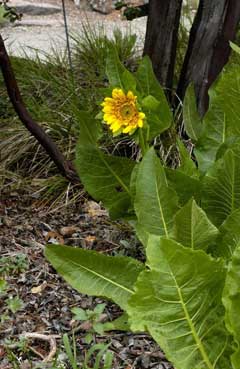 |
|
Gary A. Monroe @ USDA-NRCS PLANTS Database |
 |
| J.S. Peterson @ USDA-NRCS PLANTS Database |
Translate this page:
Summary
Physical Characteristics

 Wyethia angustifolia is a PERENNIAL growing to 1 m (3ft 3in).
Wyethia angustifolia is a PERENNIAL growing to 1 m (3ft 3in).
See above for USDA hardiness. It is hardy to UK zone 9. It is in flower from August to October. The species is hermaphrodite (has both male and female organs) and is pollinated by Insects.
Suitable for: light (sandy) and medium (loamy) soils and prefers well-drained soil. Suitable pH: mildly acid, neutral and basic (mildly alkaline) soils. It cannot grow in the shade. It prefers moist soil.
UK Hardiness Map
US Hardiness Map
Synonyms
Plant Habitats
Cultivated Beds;
Edible Uses
Edible Parts: Leaves Seed
Edible Uses:
Seed - cooked. They can be used as a piñole[168, 257]. The seed can be dried, ground into a powder and used as a thickener in soups or can be added to cereal flours when making bread etc[168, 257]. Young leaves - raw[168].
References More on Edible Uses
Medicinal Uses
Plants For A Future can not take any responsibility for any adverse effects from the use of plants. Always seek advice from a professional before using a plant medicinally.
Diaphoretic Febrifuge Poultice
A poultice of the pounded root has been used to draw blisters[257]. A decoction of the leaves has been used as a bath to promote perspiration and thereby treat fevers[257].
References More on Medicinal Uses
The Bookshop: Edible Plant Books
Our Latest books on Perennial Plants For Food Forests and Permaculture Gardens in paperback or digital formats.

Edible Tropical Plants
Food Forest Plants for Hotter Conditions: 250+ Plants For Tropical Food Forests & Permaculture Gardens.
More

Edible Temperate Plants
Plants for Your Food Forest: 500 Plants for Temperate Food Forests & Permaculture Gardens.
More

More Books
PFAF have eight books available in paperback and digital formats. Browse the shop for more information.
Shop Now
Other Uses
Dye
A lemon-yellow dye is obtained from the flowers[168]. A gold to brass dye is obtained from the flowers, leaves and stems[168].
Special Uses
References More on Other Uses
Cultivation details
Requires a free-draining, gritty but moisture-retentive soil in a sunny position[200]. Plants are intolerant of drought[200]. According to [200] this species requires climatic zone 9, meaning that it can only tolerate occasional light frosts. This is somewhat questionable since the plant's native range extends northwards to Washington where the winter temperatures often fall much lower than this.
References Carbon Farming Information and Carbon Sequestration Information
Temperature Converter
Type a value in the Celsius field to convert the value to Fahrenheit:
Fahrenheit:
The PFAF Bookshop
Plants For A Future have a number of books available in paperback and digital form. Book titles include Edible Plants, Edible Perennials, Edible Trees,Edible Shrubs, Woodland Gardening, and Temperate Food Forest Plants. Our new book is Food Forest Plants For Hotter Conditions (Tropical and Sub-Tropical).
Shop Now
Plant Propagation
Seed - we have no information on this species but suggest sowing the seed in a greenhouse or cold frame in early spring. Use a very freely-draining compost, prick out the seedlings into individual pots as soon as they are large enough to handle and plant out into their permanent positions when they are large enough. Careful division of the crown as the plants come into growth in spring[200].
Other Names
If available other names are mentioned here
Native Range
NORTHERN AMERICA: United States (Oregon, Washington, California)
Weed Potential
Right plant wrong place. We are currently updating this section.
Please note that a plant may be invasive in one area but may not in your area so it's worth checking.
Conservation Status
IUCN Red List of Threatened Plants Status :

Growth: S = slow M = medium F = fast. Soil: L = light (sandy) M = medium H = heavy (clay). pH: A = acid N = neutral B = basic (alkaline). Shade: F = full shade S = semi-shade N = no shade. Moisture: D = dry M = Moist We = wet Wa = water.
Now available:
Food Forest Plants for Mediterranean Conditions
350+ Perennial Plants For Mediterranean and Drier Food Forests and Permaculture Gardens.
[Paperback and eBook]
This is the third in Plants For A Future's series of plant guides for food forests tailored to
specific climate zones. Following volumes on temperate and tropical ecosystems, this book focuses
on species suited to Mediterranean conditions—regions with hot, dry summers and cool, wet winters,
often facing the added challenge of climate change.
Read More
Expert comment
Author
(DC.)Nutt.
Botanical References
71200
Links / References
For a list of references used on this page please go here
Readers comment
| Add a comment |
|
If you have important information about this plant that may help other users please add a comment or link below. Only comments or links that are felt to be directly relevant to a plant will be included. If you think a comment/link or information contained on this page is inaccurate or misleading we would welcome your feedback at [email protected]. If you have questions about a plant please use the Forum on this website as we do not have the resources to answer questions ourselves.
* Please note: the comments by website users are not necessarily those held by PFAF and may give misleading or inaccurate information.
To leave a comment please Register or login here All comments need to be approved so will not appear immediately.
|
Subject : Wyethia angustifolia
|
|
|
|